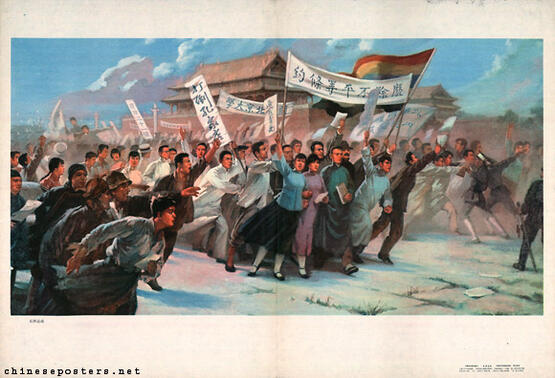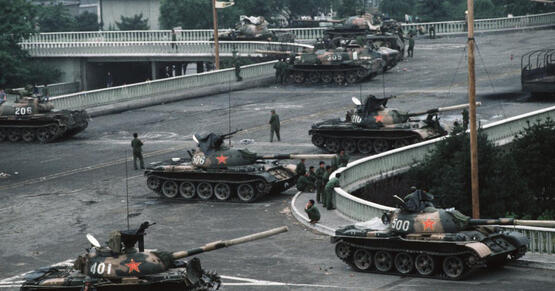Tiananmen Square
Forms of Resistance - Ivanna Savage

Tiananmen Square in Beijing, China. Photograph: https://jeanneboden.typepad.com/jeanneboden/2009/05/tiananmen-%E5%A4%A9%E5%AE%89%E9%97%A8-gate-of-heavenly-peace-.html
𝗪𝗵𝗮𝘁 𝗶𝘀 𝗧𝗶𝗮𝗻𝗮𝗻𝗺𝗲𝗻 𝗦𝗾𝘂𝗮𝗿𝗲?
Tiananmen Square, (天安门广场), is located in Beijing, China, and is the largest city square in the world. It is named after its north gate, Tian'anmen gate (“Gate of Heavenly Peace”), that divides it from the Forbidden City, a palace that one could not enter nor leave without the emperor's permission. The gate was built in 1415, and the square was built in 1651.
Sources
Where I got my information from
https://www.britannica.com/topic/Tiananmen-Square
https://www.britannica.com/event/May-Fourth-Movement
https://www.touropia.com/city-squares-around-the-world/
https://www.chinahighlights.com/beijing/attraction/tiananmen-square.htm
https://alphahistory.com/chineserevolution/may-fourth-movement/
https://chineseposters.net/themes/may-fourth-movement
https://www.history.com/this-day-in-history/tiananmen-square-massacre-takes-place
https://www.pbs.org/wgbh/frontline/article/timeline-tiananmen-square/
https://www.heritage.org/asia/commentary/tiananmen-square-massacre-30-years-later
Cited
Definitions:
Anti-imperialist: someone against an emperor's dictatorship.Resistance: refusing to accept something and doing something in order to prevent that thing that you’re against.
May Fourth Movement (五四运动)
After World War I was over, China assumed that it would be able to take back what is now known today as Shandong Province, which had German occupants. When China found out in April of 1919 that they would not be getting their way and their territories were being given to Japan instead by Germany, it triggered the May Fourth Movement.
The May fourth movement was a movement that happened on May 4th, 1919; it was an anti-imperialist movement. The people of China did not like the choices of the government and didn’t want to be dictated by China. They wanted their independence back, and were now unhappy at how China was refusing to sign the Treaty of Versailles, a peace treaty that was later signed on June 28th, 1919 that ended World War I.

Poster of the May Fourth Movement, 1976. https://chineseposters.net/themes/may-fourth-movement
May 4th, 1919: Over 3.000 students from colleges broke out in anger because of their government’s decisions. They burned houses, one of them belonging to the minister of communication’s. The May Fourth movement is also referred to as the New Culture Movement, which is the time period that lasted from 1915–1921. The protests from this movement carried on until they caused the Tiananmen Square Massacre on April 15, 1989.
Presumption
Unfortunately, Tiananmen Square is a location where lots of brutal events took place in the past. It was the gathering place for thousands of Chinese people in protest against their government on multiple occasions. It has also been remodeled numerous times and seen the deaths of innocent protestors in its many years of standing.
This amazing structure, however, can be used as an amazing example of resistance. Protestors would go to this structure attempt to resist against the government, and the government would resist against them, which I personally think is both amazing and also scary. The most important thing I learned while doing this project is that resistance goes both ways: for the people who are resisting, but also towards the sometimes higher classes who are also, in a way, resisting in certain ways against the people.
But how was it a resistance, and why is it important?
Tiananmen Square Massacre (天安门广场大屠杀)
In 1989, the Tiananmen Square Massacre took place. On the 17th of April that year, thousands of college students went to Tiananmen Square in Beijing to grieve for their general secretary, Hu Yaobang, who had just passed away two days prior. Yaobang was seen as a hero and was a positive figure in the eyes of many; he attempted to help those who affected by the Cultural Revolution.
His death caused people to notice and complain about inflation, prices, housing. The number of protesters grew and grew every week, until there was a massive amount of them. The Chinese party leaders are aware of the protestors and try to focus on a way to get the them to stop.
On May 4th, protestors went to Tiananmen Square to remember the events of the May Fourth Movement. One month later, on June 4th, troops stormed the square and fired at the crowd of protestors. Thousands of protesters tried to escape the brutal Chinese attack, and other protesters fought back by throwing various objects at the firing vehicles. On this day, thousands of protesters were killed and arrested.

Troops in tanks during the massacre of 1989. https://www.heritage.org/asia/commentary/tiananmen-square-massacre-30-years-later
Why It Was A Resistance
Throughout all of these events, one factor is always present: protest. No matter where you live, there are always going to be disagreements. Whether it be within the state, city, or house you live in, there will always be some form of protest, no matter what the reason. When someone decides things will be one way, but someone else fights back against that decision, even if it’s not physically, that is a form protest. Signing petitions on a website that contribute to a certain cause in order to change the outcome of something is also a form of protest. People commonly take to the sidewalks in their city to protest against almost anything and everything. If there are lots of protestors, they are, in a way, coming together and attempting to resist against people higher in society than them.
Tiananmen Square’s long existence has in so many ways circulated around resistance; and I learned during this project that resistance can go both ways, which is exactly what happened during events at Tiananmen Square. Both China’s people and its leaders themselves were in protest against each other, and during many events were resisting one another and fighting for what they wanted or envisioned they needed. The people wanted one thing, and attempted to resist, while their government was trying to stop them and get them to leave entire situations alone.
I think that two-way resistance is present in so many historical and present day events, but we don’t notice it’s there, or think about it, because it’s not something a lot of people notice. It can be used in great ways to explain almost anything, because everything has at least two sides to it.
These two major events have a connection because one’s happening caused the other, and together they created one big cycle of resistance because during this time period, the conflicts and protests were never really put to rest.